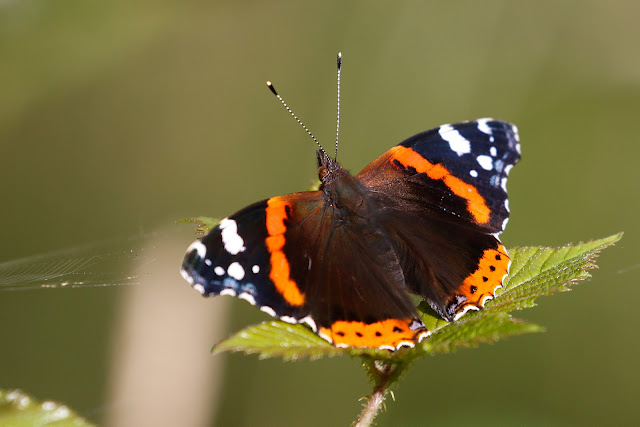It was to be the usual route, along Gradwell and then into Old Down across the fields. In the paddocks before crossing the field was a Song Thrush which appeared to still be feeding young as it foraged the grass along side the hedge.
In the woods as we came into an area of sunlight the Meadow Browns and the Gatekeepers were still around in good numbers, however new as a very smart Peacock on the bramble flowers.
Along the main path towards Swelling Hill the long grass here is attractive to the skippers, and I found an Essex Skipper resting on a dried grass stem, the first of the year
While there were plenty of Gatekeepers about and it is easy now to overlook them, this one sitting with wings open on the seed head of another grass.
Red Admirals have also been around in good numbers this year, they could be seen chasing other butterflies up into the canopy, but would also come to rest on the bramble leaves in the sunshine.
They have a very powerful flight, and as they pass you their white marking flash against the dark background of the trees.
As we walked along the path it is best to keep checking the bramble as butterflies continually fly up. While watching the Gatekeepers fly away I noticed one deeper orange butterfly continuing to sit in the sun. Slightly smaller, and with more markings it turned out to be another first for the year, the Small Copper.
Along with Small, Large and Green-veined Whites, in the short time we had walked through the wood we had seen eleven species, and this soon became twelve when I found a Large Skipper.
Just before the way out of the wood yet another Red Admiral basked in the sunshine.
There was very little else about as we walked home.
On Tuesday through out the day it was warm and humid, but as is the way in this country, the heat was to spark off thunderstorms. Early evening they had not arrived in Four Marks, but the blue skies had been replaced by a blanket of grey cloud. It was though still very warm and humid.
From inside the house, with all the windows open I could hear the contact calls of Long-tailed Tits, and as I came down stairs I could see a group of at least eight juvenile birds around the feeders. Then they moved to the bird bath, and along with juvenile Great Tits, Blue Tits and a single Coal Tit, they started to approach the water. It was clear they wanted to bathe, but a combination of wariness, and perhaps experience contributed to quiet an amusing situation.
By the time I had got my camera the Coal Tit had moved on, but the Long-tailed Tits and Blue Tits were still around. The Blue Tits were a little more confident and adept at washing.
Showing the long-tailed Tits what they need to do.
It seemed the Long-tailed Tit knew it had to bend down and shake itself, what it didn't seem to understand was the need to do it in the water.
By the side of the bath they were settling on the perch, and it looked as if they were taking turns to use the diving board to jump into the water.
Three of them lining up to get yet more instruction on how to bathe.
The Blue Tit has that surprised look as if to say what was that!
Finally they realise that to bathe you have to get into the water.
Another joins in, and there are now four around the bath.
They don't stay long, and returned to the tree, while a Blue Tit returns and are joined by a juvenile Great Tit.
But another two return, under the watchful eye of the Blue Tit, and end up looking like a pair of drowned rats.
As well as the stills I did manage some video, but as always as a last thought so all the main action was over. But at least you get some idea of how cautious and uncertain they were, and also you can see another trying to wash out of water.
While all this was going on the Robin sat looking at us in the tree, expecting us to put out the mealworms!
The rain finally came, but the tits all stayed in the trees going from feeder to the leaves. The thunderstorms arrived with a vengeance during the night with plenty of lightning and loud thunder accompanied by some torrential rain. This year the summer has been very good and the storm didn't seem to make you feel down. it was almost welcomed, and enjoyed. That may not be the case if the good weather has gone, but somehow I don't think so.




























